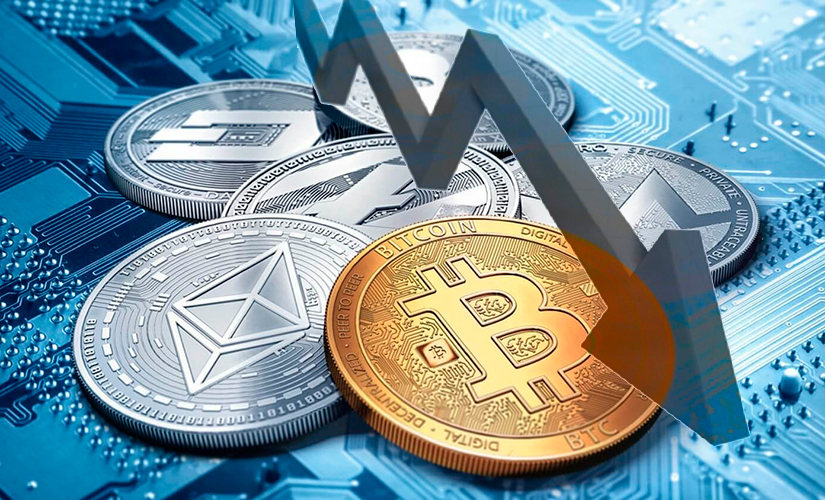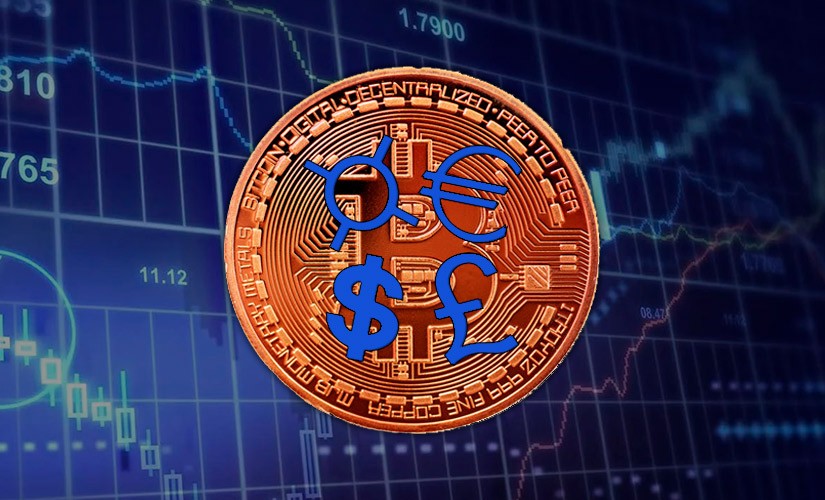
One of the features of decentralized networks is anonymity adjacent to transparency. User observers can learn about all transactions in the blockchain. Only names will be withheld, while wallet addresses, time, status, and even the amount are public knowledge. However, this is not a service for snooping on people. By leveraging observers, you can view your own transfers and analyze the state of the network. It is not difficult to use them if you understand once how to check a bitcoin transaction in the blockchain by wallet number.
What is a blockchain browser
This is a resource that collects detailed information about the key indicators of the decentralized network, the history of transfers. In the early years of Bitcoin, blockchain users were forced to work with an inconvenient command line. Now there are simple services that allow you to quickly check the status of a transaction and the state of the network.
Each blockchain has its own browser. If a user transfers Bitcoin, Bitcoin Explorer is suitable, and in the case of Ethereum – Etherscan. They work on the same principle and have a similar interface, but are connected to different networks.
There are both official observers (created by blockchain developers) and third-party services that collect information about several platforms simultaneously. There is no significant difference between them, so you should choose one based on comfort and understandability of the interface.
Why use
Unlike banking systems, blockchain is a decentralized and open network. It does not have a support service that can check the status of a transfer. Its functions are performed by reviewers. The services contain all the information that people may need. Reasons for their use:
- Checking the success of node creation (for miners).
- To view the status of a transaction (e.g. whether a payment has been received or not).
- Determining the optimal fee to quickly complete a transfer.
However, browsers are powerful services. Their functionality is not limited to the fact that the user can track and view bitcoin transactions in the blockchain. The sites contain detailed information about the state of the decentralized network. It will come in handy for those who plan to invest in tokens or start mining. In Bitcoin Explorer you can see such data:
5020 $
bónus para novos utilizadores!
A ByBit fornece condições convenientes e seguras para a negociação de criptomoedas, oferece comissões baixas, alto nível de liquidez e ferramentas modernas para análise de mercado. Suporta negociação à vista e alavancada e ajuda os principiantes e os operadores profissionais com uma interface intuitiva e tutoriais.
Ganhe um bónus de 100 $
para novos utilizadores!
A maior bolsa de criptomoedas onde pode iniciar de forma rápida e segura a sua viagem no mundo das criptomoedas. A plataforma oferece centenas de ativos populares, comissões baixas e ferramentas avançadas para negociação e investimento. O registo fácil, a alta velocidade das transacções e a proteção fiável dos fundos fazem da Binance uma excelente escolha para os comerciantes de qualquer nível!
- The exchange rate of the coin and the value of one satoshi.
- Market capitalization.
- Hash rate and network complexity.
- The number of coins in circulation.
- Time until the next halving.
Investing in tokens or engaged in mining, it is worth regularly checking this information.
It will allow you to make a forecast to switch to other coins in time, increase earnings and minimize costs.
How transactions are processed in blockchain
Decentralized networks function according to a special mechanism, which differs from the usual systems of bank transfers. Transactions are processed according to the following algorithm:
- A user who wants to transfer cryptocurrency to another person specifies his address in the wallet and gives a confirmation for sending.
- Information about the transaction enters the blockchain. After initial processing, the network automatically queues it in the pool of unconfirmed transactions. The speed of the transfer depends on its place in the pool.
- Miners take transactions from the pool and make a new block. They process several transactions at once and from the information about them assemble the next link in the chain, which contains all the metadata about the transfers.
- Miners sign the block to add it to the network. They perform complex mathematical tasks to match a particular combination of signs. To do this, miners use powerful ASICs and video cards that perform calculations quickly.
- The first participant to complete the combination adds a block to the chain and broadcasts the signature to the rest of the nodes.
- Other miners check the legitimacy of the cell. To do this, they take the data string of the block being broadcast and compare the hash sums. If the information matches, the miners give confirmation to integrate the block into the chain. At this stage, users can already find and verify bitcoin transaction IDs online.
- The transaction is executed, and the recipient receives the digital currency on his credentials.
Weight
Blockchains differ in the size of the nodes, due to which the speed of transaction processing is not the same. The more transfers can be fit into a single chain link, the faster users will send and receive money.
Before 2017, the maximum weight of a Bitcoin block was 1MB. After the Segregated Witness softfork, its size increased to 2 MB. Many factors affect the exact weight, so on average, a block takes about 1.6-1.8 MB.
The transaction exists online as a record of the movement of bitcoins between 2 wallets. It includes 3 parts.
| Elemento | Descrição | Weight (in bytes) |
|---|---|---|
The exact weight is calculated automatically by the formula: Input * 148 + Output * 34 + 10. It should be noted that there should be at least 2 addresses on the “output”. For example, if there are 5 transactions in the block, the formula will be as follows: 5 * 148 + 10 * 34 + 10 = 1090 bytes.
This information is required only for miners and validators. Normal users do not need to know it.
Comissões
In addition to the reward for creating a block, miners receive a fee from users. Its size determines the speed of operations. The higher the fee, the faster it will be added to the block.
The calculation of the fee depends on the number of bytes. If the user has set a fee of 7 sat/B, then for a standard operation weighing 226 B, he will pay 1582 Sat.
It is recommended to consolidate amounts on 1-2 wallets rather than storing some coins on 20 or more addresses, because the transaction fee does not depend on the number of tokens. If you consolidate assets, you can put the fee slightly above average and transfer money quickly with minimal costs.
Speed
Transaction processing time is highly dependent on the technicalities of the decentralized network. Bitcoin is among the slowest blockchains due to its relatively small block size and complex math to create a signature. Due to the popularity of the platform and the huge number of transactions in the queue, users are forced to constantly increase the commission.
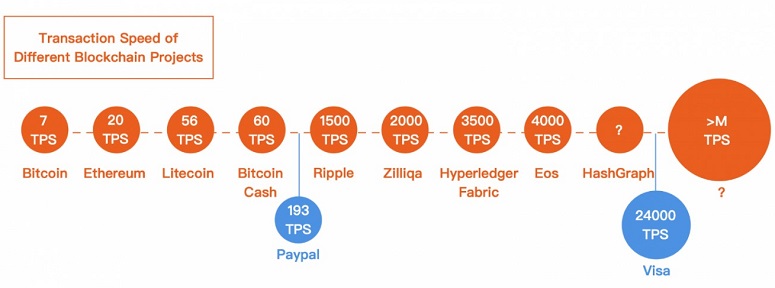
Bitcoin processes about 7 transactions per second. This is a very small figure. The blockchain is inferior to Visa payment system with 24,000 transactions by more than 4,500 times. Developers of new decentralized networks are trying to make blockchains faster, which is important for their popularization and spread. Rating of systems with minimal processing time:
- UMI – 65 thousand operations per second.
- Solana – 50 thousand.
- Aleph Zero – 40 thousand.
Statuses
To understand at what stage a transaction is, you need to use the browser. Depending on the speed and network load, you can find out the status on the site in 5-30 seconds. Having opened the transfer card, the user will see one of 4 options:
- Success. Cryptocurrency has been delivered to the specified address.
- Failed. An error occurred, because of which the operation was canceled and the money returned to the balance. Perhaps, the user specified a non-existent recipient’s address.
- Pending. The transaction has entered the memory pool and is waiting for miners to add it to the block.
- Dropped and Replaced. The user has changed the transfer parameters, so the record has become irrelevant.
If the transaction is in the Pending status for a long time, it is worth increasing the commission by 20-25%. Miners constantly push back the least profitable transactions, because of which some transfers can wait up to 24 hours for processing.
How to check a bitcoin transaction in the blockchain
To find out the status of a transfer through the decentralized network, users engage free browsers. They search, verify and track Bitcoin transactions in real time. It takes no more than a minute to find out the status.
Search TxID
To quickly find information about a transfer, you need to know its unique identifier. TxID is assigned to each transaction after initial processing. It can be copied in the wallet. For example, on the Binance exchange, users see the addresses and TxID on the “Transfer History” page in the far right column.
It is a 64-digit number consisting of numbers and Latin letters. Knowing the TxID, you can easily find any transaction. To view it, you need to open the browser site and insert the identifier into the search bar. After a few seconds, the service will show the record.
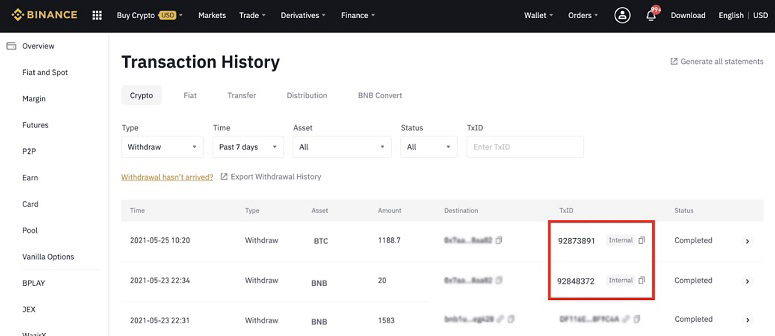
How to understand the contents of the transaction
In the case of Bitcoin, the user can look at the information on Blockchair. The card includes:
- Sender and recipient.
- The amount of the transaction and the time.
- Number of confirmations. It takes a minimum of 6 times to verify a transaction to add it to the blockchair.
- Size. The weight of the record.
- Fees per byte and weight unit (transaction).
- Whether RBF is enabled. This is the Replace-By-Fee function (changing the service charge without editing other data).
- Lock Time. A parameter that specifies the node height until which the transaction will be delayed. It is selected by the user.
- Coinbase. Usually this item is negative, as it is associated with coins that were not in circulation before. Such tokens are received by miners who create blocks. The network unfreezes the cryptocurrency and sends it to them.
A popular method of tracking transactions
The most common way to find out the status of a transfer is Blockchair. It supports 17 popular cryptocurrencies, including Bitcoin, Ethereum, Litecoin, and others. The service allows you to find a transfer using the following data:
- The address of the sender’s or recipient’s wallet.
- Block ID. If you enter it, you will have to find the desired transaction yourself in the list.
- TxID. This is the most accurate and convenient option, since the user will immediately see the record he is looking for.
Checking transactions in the Bitcoin network
To find out the status of the transfer in the blockchain, you should use BTC.com. This is a service in Russian, which differs from Bitcoin Explorer by a more understandable interface.
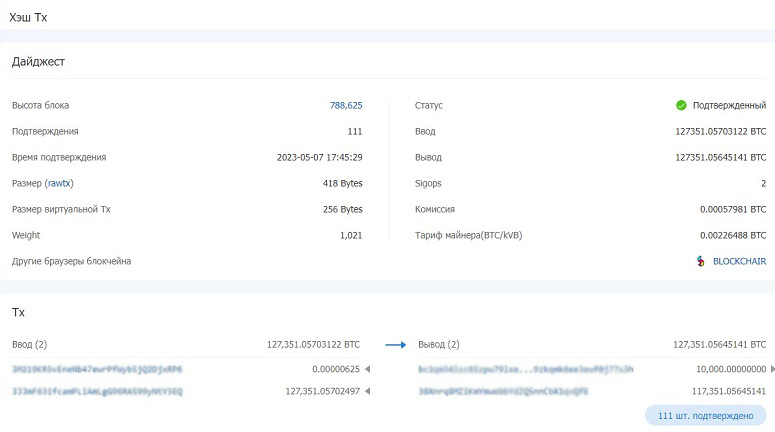
As in other browsers, the user should specify the wallet address, block or transaction ID. He will see all the details of the transaction and can check the recipient’s balance if desired.
How to track stablecoins
Such coins technically do not differ from Bitcoin and Ethereum. Their difference is that stablecoins are tied to the quotes of fiat currencies or exchange commodities to stabilize the rate of the digital asset. To view the transfer status, you must first find out the platform to which the coin belongs, and then find a browser tied to a specific network.
USDT exists in 15 blockchains at once. The list includes popular ones – Ethereum, Binance Smart Chain, Omni.
You can determine the number by the initial characters of the address. If it starts with 0x, it means that the wallet works in the Ethereum USDT network, and the letter T appears when coins circulate in TRC. To track the movement of stablecoins, the following are used:
- Tokenview. The versatile browser works with more than 20 blockchains. On the home page, you need to enter the transfer ID to see its status, recipient address, and fee amount.
- Etherscan. Ethereum network observer tracks the movement of all coins, including stablecoins.
Other blockchain observers
Many services have been created to view transfers. People using cryptocurrency mostly work with the following platforms:
- Blockchain.com. The platform not only collects information about transactions, but also tracks the price dynamics of digital assets, the number of blocks in the network. The site also offers a catalog of DeFi projects, NFT browser.
- CoinMarketCap Blockchain Explorer. A native browser from a foreign aggregator platform works with Bitcoin, Ethereum, Litecoin and BNB Chain networks. It contains analytical data about blocks, market capitalization, volumes of cryptocurrency in circulation. The only drawback is the lack of Russian language.
- TradeBlock Explorer. The minimalistic service is more suitable for traders than for ordinary users. It is mainly chosen because of the function of tracking blockchain activity in live mode.
- BlockCypher. It is an observer of Bitcoin, Bitcoin Testnet, Ethereum, Grin, Litecoin, Dogecoin, and Dash networks. In addition to standard functions, it offers users additional tools (e.g., estimation of confirmation time, optimal commission).
Resumo
Cryptocurrency transfers are always added to a public registry (blockchain), so the user can check the status of his or someone else’s transaction. This partly hurts anonymity, but Bitcoin and other popular networks position themselves as open and transparent platforms.
To transfer money, the user must choose the optimal fee. If it is too low, miners will have no incentive to perform the transaction quickly. The advantage is given to those who offer the highest reward per transaction. If a transaction sits in the memory pool for a long time, it is recommended to increase the commission based on the state of the blockchain or choose a time when it is less stressed.
Perguntas mais frequentes
💳 Who can cancel a transfer?
There is no person who can influence the exchange of data in decentralized networks. The blockchain is designed so that all events are irreversible and beyond the control of humans.
❔ How to combine small amounts on one wallet?
To do this, coins are sent to an address when the network is minimally loaded.
🔔 Why is decentralization important for blockchains?
It is needed to create an immutable and open data registry that is secure from fraudsters.
🔥 How do I know the optimal fee?
It is recommended to look in your browser to see how much users pay for sending money. If speed is not important, you should specify a similar value or increase it by 5-10% for faster processing.
⚡ How can I hide my finances so that others don’t recognize my balance?
You can use cold hardware wallets. They are not connected to the Internet, so they are more secure and anonymous.
Há algum erro no texto? Realce-o com o rato e prima Ctrl + Entrar
Autor: Saifedean Ammous, especialista em economia da criptomoeda.


